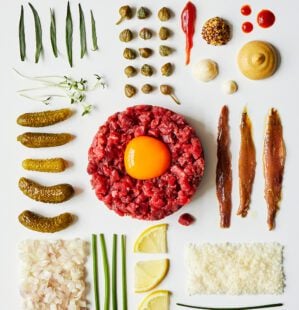My first experience with steak tartare was somewhat traumatic. At 17, my best friend and I were visiting Paris on our own. Having accidentally picked a hotel in the middle of the red light district and on top of bravely trying snails for the first time, it was mistakenly ordering a plate of raw beef that horrified me most.
Years later, that embarrassment long forgotten, it’s one of my favourite dishes (it’s even part of my death row meal) and steak tartare is having a bit of a moment. An innovative version appears on most small plates menus these days – and I’m not complaining. Riffs on the classic, including soy-cured egg yolks, oxtail jelly and smoked oyster emulsions, are fun excursions, but for our best-of-the-best version we’re looking at something more traditional and going back to the start.

An intriguing story surrounds the origins of steak tartare, which, as legend tells, is named after the 13th century ‘Tartars’, or Mongols as we now know them. They would place a strip of horsemeat under their saddles at the start of the day, then have a nicely tenderised piece of raw meat for supper. Sadly, the story has no foundations and the dish is, in fact, named after tartare sauce, which shares many of the same ingredients: egg yolk, oil, capers and cornichons.
As no cooking is involved, steak tartare is pretty simple to recreate at home. It’s all about good quality beef, keeping it cold and preparing it fresh. Even chilling the mixing bowl before using it is .























